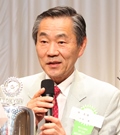Birds and Humans��Searching for a True Symbio
May 1,��2013
Mr. Yoshihiro Hayashi
Director General, National Museum of Nature and Science
Director General, Yamashina Institute for Ornithology
 ��How to maintain symbiosis between humans and other frail creatures is no simple matter, as ��humans�� are the greatest menace to all other living things. Japan faces various issues, including aging population, declining birthrate and depopulated areas, but I think the greatest problem is damages caused by wild animals in hilly and mountainous areas that account for 70% of our land.
��How to maintain symbiosis between humans and other frail creatures is no simple matter, as ��humans�� are the greatest menace to all other living things. Japan faces various issues, including aging population, declining birthrate and depopulated areas, but I think the greatest problem is damages caused by wild animals in hilly and mountainous areas that account for 70% of our land.
��Damages caused by birds and animals in hilly and mountainous areas
��Damages caused by boars, deer, monkeys and bears that appear in satoyama (managed woodlands) and satochi (mountain villages) total 20 billion yen each year. For example, the deer eat up new shoots and thus hamper reforestation through ��coppicing.�� Withered satoyama and satochi trigger landslides after heavy rainfall, a phenomenon observed across Japan.
��Various measures are taken to stop damages, including permission to capture the doe or extension of the shooting period, yet no improvement has been made.
��Increasing damages caused by black bears
��Although they look cute, black bears can turn into threatening animals when they appear near our house to forage for food. School children who commute on the mountain passes on foot are scared of encountering them.
��Monkeys can distinguish people
��Monkeys are less apprehensive towards women and children. Therefore we disguise ourselves as older women when we need to put GPS on their necks to monitor their lifestyle.
��Damages caused by alien species
��Raccoons look cute, but they eat up watermelons using their long fingers and even attack chickens. Nutria was brought into Japan for its fur. Both of them are not native to our country.
��What is a desirable ��human-animal relationship��?
��Animal protection activists take a radical stand and insist that ��not a single creature should be killed.�� A cool-headed scientific assessment is necessary, with extensive public discussions, to search for a common ground and identify the desirable ��human-animal relationship.��
��The Japanese have kept an affectionate eye on creatures
��We have long worked in the fields, mountains or on shores and have kept an affectionate eye on creatures. Many festivals and prayers are offered to thank the rich blessings of nature. Children feel familiar to animals that appear in folk tales.
��Revival of the white storks
��White storks once prevailed across Japan, but aggressive development drove the birds to extinction in the 1960s when Japan took a new path towards modern rationalism. The last stork was spotted in Toyooka, Hyogo Prefecture.
��In 1989, the first chick hatched in Japan after a couple of decades of extinction, and we succeeded in releasing the storks in 2005. They are occasionally spotted in Toyooka, as well as in Kanto or Shikoku areas today, a scene that dates back to the 1960s. I think this successful reintroduction program exemplifies true ��symbiosis between animals and humans.��
��Mysterious and miraculous islands of Ogasawara
��Ogasawara Islands became the UNESCO World Natural Heritage Site in 2011, where many endemic animals inhabit, including the Japanese wood pigeons and brown booby. Before the UNESCO registration, there had been many stray cats that threatened wild life on the Islands. Residents of Ogasawara collaborated with the Ministry of the Environment and Tokyo Veterinary Medical Association and made a miraculous achievement in eliminating cats without killing them at all. Cats were captured, received tender care of veterinary nurses and lead a happy life as pet cats today.
��Relocation Program of short-tailed albatross
��Our Institute engages in a big program to revive the short-tailed albatross. By 1902, as many as 5 million albatrosses were killed on Torishima for their downs and feathers and they were on the verge of extinction in the 1930s.
��Albatross is a seabird and they spend their lives on the ocean, yet they return to Torishima during the breeding season. The good news was that we discovered the surviving albatrosses back on Torishima in 1951. The bad news is that Torishima is a volcanic island and there is a possibility of an eruption at any time, which can possibly kill off the birds. Our Institute, therefore, has been implementing the relocation program of the birds from Torishima to Mukojima since 2010. In early February each year, 15 chicks are relocated by a helicopter and released into the wild. As a joint initiative with the US, we attach a GPS device on each bird to monitor their location. An albatross is a truly remarkable seabird. We have observed them flying from Mukojima and Torishima up to Sanriku shoreline to catch fish and then fly back to feed the chicks.
��Their annual migration ranges across the whole North Pacific area and reaches the West Coast of the US. There are many different albatross species, but the albatross we find in Japan is the genuine and authentic. We have made progress in reviving them and making them fly over the North Pacific Ocean. I believe this situation proves the true symbiosis between humans and birds.